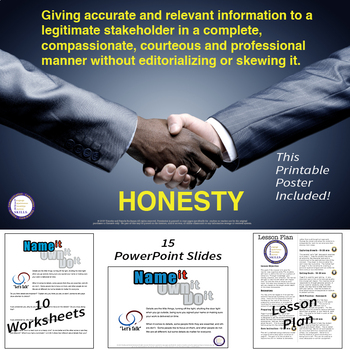Honesty Lesson - Distance Learning
- Zip
Description
The goal of this lesson is to cause behavioral change in the learner. The learner will learn to define the skill as a pattern of behaviors that he or she has a choice over in their personal life. Through knowledge, goal setting, practice, and reflection, the learner will gain a new understanding of the practice and impact of this skill in their own life and those around them. (Total time, 45-60 Minutes)
This includes the complete teaching package for Honesty, including files for:
Reproducible Workbook Pages (including a “How to Teach the Material” guide)
PowerPoint Presentation
11 X 17 Definition Poster
Discussion Guide
Grading Rubric
Your students will learn these important keys to Honesty:
Accuracy - the sooner we record or share the truth, the more accurate it will be
Objectivity - It is easy to allow our biases to influence the truth, fight your biases
Vulnerability - Being willing to let honesty shine an unwanted light on you
Courage - Some people do not want to hear the truth, but we still must speak it
Empathy - take the time to think through how the truth will impact someone
Respect - Deliver truth based on who deserves to have it regardless of other factors
Truth is something that can be hotly debated today because it is subjective to many people. Rather than delve into the moral debate of this topic, we need to center instead on the issue of honesty.
Truth relates to the validity or value of the information, whereas honesty is a matter of how you handle and deliver the information. That is what you want to deal with in this coaching session - how you share the information you have been entrusted with.
Inside the Workbook Pages:
A narrative of the skill
A “working” definition of the skill
An easy to use and understand behavior model
Two discussion sections
Goal setting
Behavior identification for change
Journaling Exercise
End of practice reflection
Discussion model
PowerPoint Presentation
Everything you need to teach the lesson and carry on the discussion exercises with your class is on the slides. This presentation is taken directly from the workbook pages and is a great compliment to the workbook. You can use this presentation in conjunction with the workbook or as a stand alone resource. We also include “My Ownership Pledge” which challenges the students to take personal Honesty for their behavior, lives, and personal growth.
Grading Rubric
This will allow you to assign a grade to the student’s work if you so choose. You can assess them in four areas: Creating a plan and goals, Situation for practice, Discussion and participation, Final personal assessment. Each of the four areas has a clear description and the rubric is scored for a total of 100 points.
Poster
This is a beautiful 11 X 17 poster. You can print it any size you wish and post it in your room as a reminder to your students. This poster has eye catching graphics with the definition of Honesty on it. Or, you can make a copy for your students to take home and post.
Discussion Guide
This is a guide with some great tips on conducting a healthy and considerate discussion for everyone involved. It explains how to get the discussion started and also how to deal with problems that may come up. This comes from years of facilitating classroom discussions and working with mangers and leaders to improve their meetings. It has great suggestions for the classroom or boardroom.
More:
This resource will help your students learn what Honesty is, how they need to change their behaviors, and how to use it in their own life through goal setting. There are two discussion sections in the lesson which you can use with the entire class or break them up into small groups. It has an easy to understand model for the skill describing the necessary behaviors, the destructive behaviors, and misconceptions. There is a section for personal goal setting and the opportunity to pick a real life situation to practice the skill. The student begins to learn how their behavior impacts those around them by identifying two people who will benefit from their growth in Honesty. Finally, a reflection section is included for the end of the week so the student can reflect on what they have learned and how it has changed them. This can also aid in Common Core goals. Harvard’s Graduate School of Education in a recent paper states: ”Educators and social and emotional learning (SEL) experts are increasingly acknowledging that building students’ SEL skills can help schools meet the Common Core State Standards(CCSS).” (https://mcc.gse.harvard.edu/files/gse-mcc/files/sel_and_common_core_1.pdf)





